ART
When the kids had gone to bed, I USED to make time for art–at least one piece a month. I selected one method per year–linoleum block cuts/prints, watercolors, collage, or silhouettes. The subject was usually public sculpture or architecture in Philadelphia, but my children also inspired me. The pieces were usually small and colorful and fulfill a need that my role as an associate professor of landscape architecture may not fulfill often enough. I often recycled material such as The New York Times Magazine, Color-aid paper I bought and used very little of during my pre-architecture years at the University of Nebraska at Omaha; or items that have accumulated in folders or boxes over the years.
Models
A peer introduced me to the work of William Christenberry while at Auburn University. Christenberry built models of objects from the landscape within which he grew up–Hale County, Alabama. This intrigued me. Landscape architects build models of proposed conditions that do not yet exist, whereas Christenberry built models of objects that exist and are falling into ruin, or have been erased from the landscape. Time is integral to his work, just as it is in landscapes. Following Christenberry’s lead, I made two models with mostly recycled materials: first, Siren on the Hill, a Thunderbolt tornado and civil defense siren that deeply traumatized me whenever it sounded as I was growing up; and second, Windmill off Capehart Road, which I documented fall to ruin.
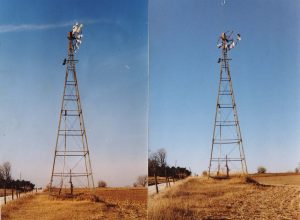
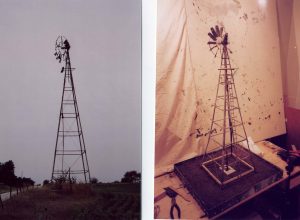
The real deal on the left. Model at right. Metal, wood, wire, dirt. 27″ x 27″ x 44″. 2003.
Blind Contour Drawings
At Auburn, my peers and I were taught to create blind contour drawings. Put simply, you look at a subject and draw on paper, without looking at the paper as much as possible. I enjoy these because of the challenge, but also because they are always unique, and never perfect. When I sketch in my sketchbook, I tend to draw blind contour drawings in black ink.
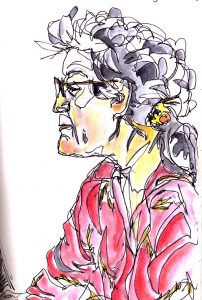
Mom and Kosmo. Ink and watercolor in sketchbook. Unknown date.
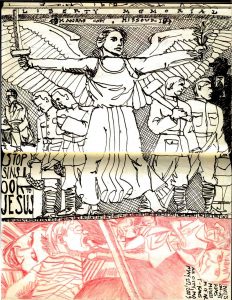
KC MO. Ink and Col-erase red pencil in sketchbook. 2009.
Watercolor
On my walk across Nebraska in 2005 I became quite good and happy with watercolors. The trip required lightweight materials and a minimum number of tools. To this day, all watercolors I use the same Liquitex value series basics artist water colors (8 oval pans in a tray with a lid), a #2 pencil, a #2 brush, and a #0 brush.
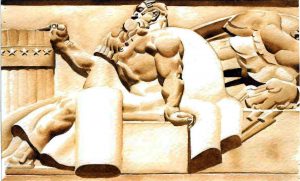
The William Penn Annex Post Office branch, 900 Market Street: “Justice,” 1940 bas relief sculptures by Donald De Lue. Watercolor on 140# paper. 5-1/2″ x 8-1/2″. 2011.
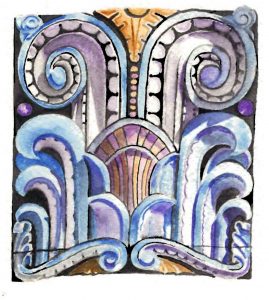
Frieze, Market Street National Bank Building, Philadelphia. Watercolor on 140# paper. 4″x 6″. 2011.
Memory Dumps
At Auburn, my peers and I were encouraged to create “Day Maps,” which recorded site/field visits using objects gathered from the site. I saw strong connections between day maps and Robert Rauschenberg’s assemblages, or Marcel Duchamp’s ready-mades. After collecting numerous odd items that were the products of an experience I had had, I made my day maps “memory dumps.” There were two purposes to these: first, make art; and second, to use stuff I had that had no use.
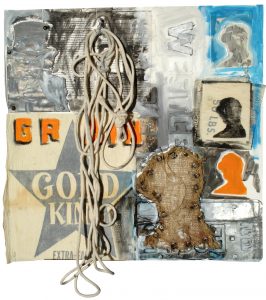
Gold King, Mixed Media, 2005.
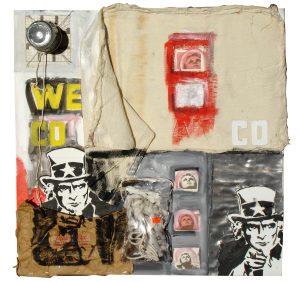
Uncle Sam, Mixed Media, 2005.
Collages
Following the New York Times Magazine collages, I began using Color-aid paper and converting photographs into collages. Having read Secret Knowledge by David Hockney, I was perfectly comfortable transferring the outlines of the subjects from photographs to copy paper with graphite paper and a pencil; Old Master painters used the camera obscura to transfer images to canvases.
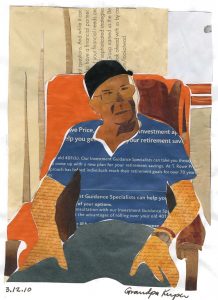
Grandpa Kuper. Pages from The New York Times Magazine glued to copy paper. 2010.
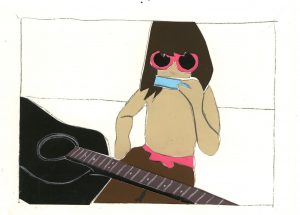
DANCE! Color-aid on copy paper. 2013.
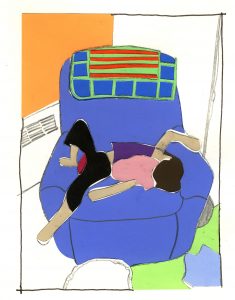
I am NOT going to sleep; sleeping. Color-aid on copy paper. 2013.
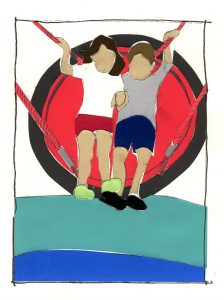
Swingin’ at Smith (Playground). color-aid paper on copy paper. 2013.
Linoleum Block Cuts
While living in Boston I read Nothing Like It in the World by Stephen Ambrose, which described the construction of the Transcontinental Railroad. I got the idea to reproduce an advertisement for the railroad by carving it our of two plywood boards.
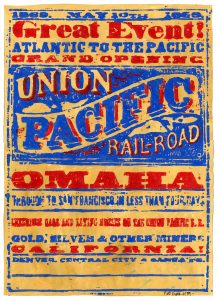
Great Event! Woodcut. Ink on paper. 2001.
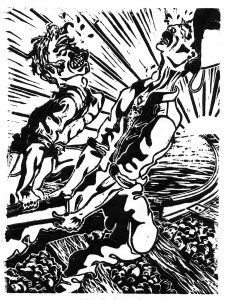
Ten Mile Day. Linoleum cut. Ink on paper. 2001.
Besides learning that plywood is a horrible material to carve into, I learned how much I appreciated the simplicity of the technique and the product, as well as, the ability to mass produce images and the opportunity to slightly alter them by changing the ink color. Thereafter, I began linoleum cuts. Since then, I have often pulled prints on blank thank you cards as a way to motivate me to work, and express my appreciation to individuals in need of thanks.
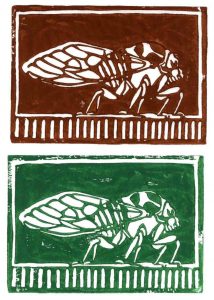
Cicada in brown and green. Linoleum block print on copy paper. 2013?
At some point I realized that I could create some of the qualities of linoleum block prints using an X-acto knife and Color-aid paper.
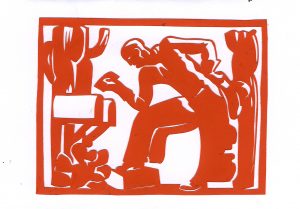
The William Penn Annex Post Office branch, 900 Market Street: “Mail Delivery – West,” 1941 bas relief sculpture. by Edmond R. Amateis. Color-aid glued to thank you card paper.
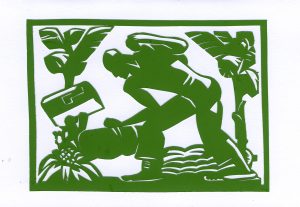
The William Penn Annex Post Office branch, 900 Market Street: “Mail Delivery – South” 1941 bas relief sculpture by Edmond R. Amateis. Color-aid glued to blank thank you card paper.